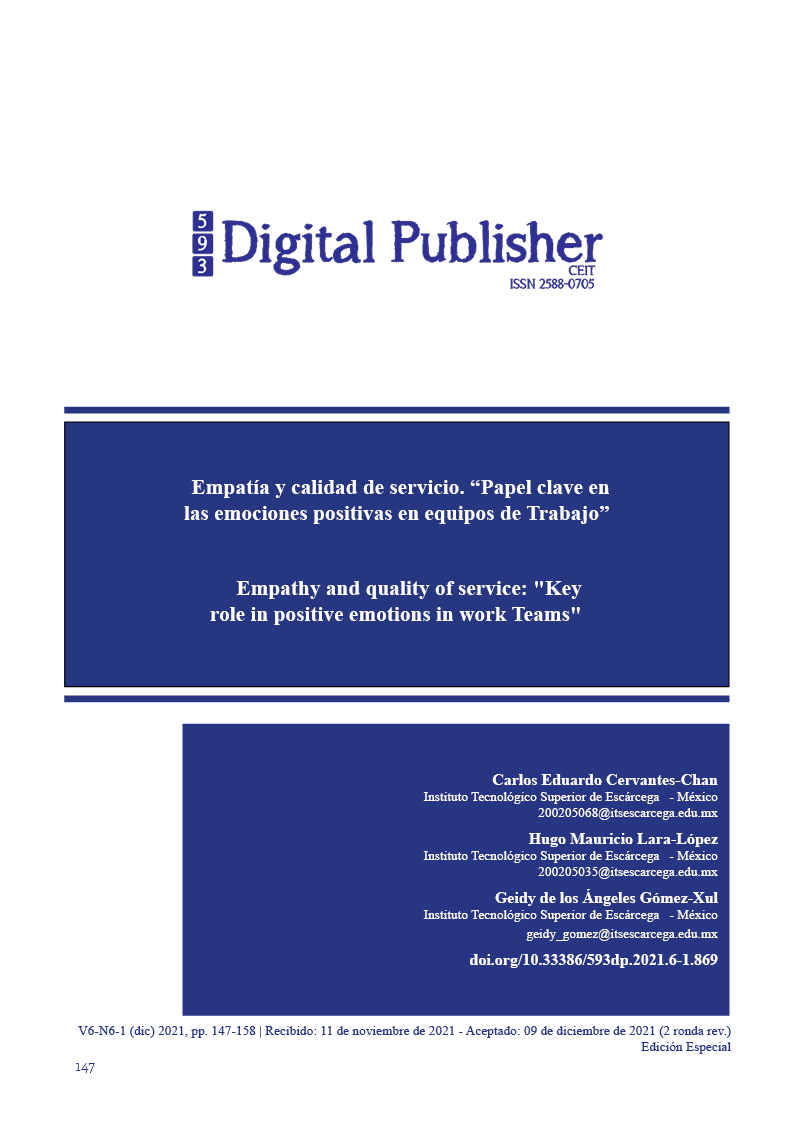Empathy and Quality of Service: "Key role in Positive emotions in Work Teams"
Main Article Content
Abstract
The purpose of this research is to analyze the relationship of the dimension of empathy with the quality of service provided to the customer based on the SERVQUAL model in a grocery store in the municipality of Escárcega, Campeche. It is very important that within the work teams that are formed in companies, positive emotions are maintained for effective development; The problem with companies is that they do not offer a process to help the client's needs. The type of research is of a qualitative descriptive type, based on data obtained through the application of a questionnaire from the SERVQUAL methodology made up of five dimensions. The results obtained with respect to empathy and the other dimensions is favorable; Consumers have the perception of the company, which provides the personnel with adequate equipment for the performance of their work functions, on the contrary, it is found as an area of opportunity for the personnel to have a personalized treatment towards their clients. It is concluded that empathy projects clients personally, it depends on the empathy that the company has for its collaborators, having to reinforce and guide on the subject of emotions, teamwork that manages to support continuous improvement in quality in the service offered by the company.
Downloads
Article Details

This work is licensed under a Creative Commons Attribution-NonCommercial-ShareAlike 4.0 International License.
1. Derechos de autor
Las obras que se publican en 593 Digital Publisher CEIT están sujetas a los siguientes términos:
1.1. 593 Digital Publisher CEIT, conserva los derechos patrimoniales (copyright) de las obras publicadas, favorece y permite la reutilización de las mismas bajo la licencia Licencia Creative Commons 4.0 de Reconocimiento-NoComercial-CompartirIgual 4.0, por lo cual se pueden copiar, usar, difundir, transmitir y exponer públicamente, siempre que:
1.1.a. Se cite la autoría y fuente original de su publicación (revista, editorial, URL).
1.1.b. No se usen para fines comerciales u onerosos.
1.1.c. Se mencione la existencia y especificaciones de esta licencia de uso.
References
Referencias bibliográficas
Alfredo. (2001). calidad en el servicio en tiendas. México: edit.
https://www.itson.mx/publicaciones/pacioli/Documents/no82/pacioli-82.pdf
Berry, L.L. (1989). Calidad en el servicio. Inglaterra: parasuman.
https://www.redalyc.org/pdf/4717/471747525008.pdf
Bravo, R. M. (2016). Gestión de Identidad Corporativa. México: RCS.
https://produccioncientificaluz.org/index.php/rcs/article/view/24859
Businessolver. (2017). Workplace Empathy. Obregon: Monitor.
https://info.businessolver.com/hubfs/businessolver-workplace-empathy-monitor-2017.pdf
Castillo. (2009). empatía del recurso en el servicio al cliente. Guatemala: esditmgj.
https://www.itson.mx/publicaciones/pacioli/Documents/no82/pacioli-82.pdf
Cohen, S. y. (1997). What makes team Works: Group effectiveness research from the shop floor to the executive. D.E: Mangement.
David. (2007). calidad en las tiendas de abarrotes. Guatemala: fut.
http://eprints.uanl.mx/362/1/1080071234.PDF
Deming. (1989). la calidad en las tiendas. Francia: crosby.
http://nulan.mdp.edu.ar/1614/1/09_administracion_calidad.pdf
Flores. (2012). empatía de recursos humanos en el servicio al cliente. Guadalajara: mex.
http://recursosbiblio.url.edu.gt/tesiseortiz/2018/05/43/Coronado-Gabriela.pdf
Frdrickson, B. (2001). The Role of Positive Emotion in Positive Psychology. Obregon: Adventure Works.
https://www.ncbi.nlm.nih.gov/pmc/articles/PMC3122271/
García Prieto, B. y. (2003). Experiencing Diversity Conflict and Emotions in Teams . California: Internacional Review.
Hernández, C. L. (2014). Empleados Saludables y Calidad del Servicio en el Sector Sanitario. Monterrey: Diana.
https://scielo.isciii.es/scielo.php?script=sci_abstract&pid=S0212-97282014000100026
Hogan, R. (1969). Development of an Empathy Scale. Columbos: Consulting.
https://psycnet.apa.org/record/1969-12966-001
Hurtado. (2011). modalidad de calidad en el servicio. Veracruz: vezga, libro.
https://www.redalyc.org/pdf/4717/471747525008.pdf
Kozlowski, I. (2006). Enhancing the Efectiveness of Work Groups and Teams. California: Supplement.
Pérez. (2005). empatía de recursos humanos en el servicio al cliente. Puebla: am editorial.
https://www.redalyc.org/pdf/167/16711589012.pdf
Quevedo, A. &. (2008). Evaluación y propuesta de Mejoras de un modelo de Atención de Usuarios en un Servicio Público. Revista economía y administración, 71.
http://www2.udec.cl/~rea/REVISTA%20PDF/Rev71/art1.pdf
Rosselló, J. y. (2008). Modelos Teóricos en el Estudio Científico de la Emoción. Madrid: McGraw-Hill Interamericana.
https://dialnet.unirioja.es/servlet/libro?código=288543
Rousseau, V. (2006). Teamwork Behaviors . Columbus: Research.
https://citeseerx.ist.psu.edu/viewdoc/download?doi=10.1.1.474.3973&rep=rep1&type=pdf
Sánchez. (2014). empatía del recurso humano. México: libros de recursos.
http://biblio3.url.edu.gt/Tesario/2014/05/43/Aguilar-Pahola.pdf
Vázquez. (2016). Empatía del Recurso en el Servicio al Cliente. Zacatecas: Librería Zac.
http://recursosbiblio.url.edu.gt/tesiseortiz/2018/05/43/Coronado-Gabriela.pdf
Zeithaml, V., & Bitner, M. J. (1985). Marketing de Servicios. México: Mc Graw Hill.




